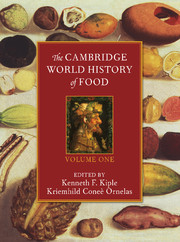Book contents
- Frontmatter
- Introduction
- Part I Determining What Our Ancestors Ate
- Part II Staple Foods: Domesticated Plants and Animals
- II.A Grains
- II.B Roots, Tubers, and Other Starchy Staples
- II.C Important Vegetable Supplements
- II.C.1 Algae
- II.C.2 The Allium Species (Onions, Garlic, Leeks, Chives, and Shallots)
- II.C.3 Beans, Peas, and Lentils
- II.C.4 Chilli Peppers
- II.C.5 Cruciferous and Green Leafy Vegetables
- II.C.6 Cucumbers, Melons, and Watermelons
- II.C.7 Fungi
- II.C.8 Squash
- II.C.9 Tomatoes
- II.D Staple Nuts
- II.E Animal, Marine, and Vegetable Oils
- II.F Trading in Tastes
- II.G Important Foods from Animal Sources
- Part III Dietary Liquids
- Part IV The Nutrients – Deficiencies, Surfeits, and Food-Related Disorders
- References
II.C.6 - Cucumbers, Melons, and Watermelons
from II.C - Important Vegetable Supplements
Published online by Cambridge University Press: 28 March 2008
- Frontmatter
- Introduction
- Part I Determining What Our Ancestors Ate
- Part II Staple Foods: Domesticated Plants and Animals
- II.A Grains
- II.B Roots, Tubers, and Other Starchy Staples
- II.C Important Vegetable Supplements
- II.C.1 Algae
- II.C.2 The Allium Species (Onions, Garlic, Leeks, Chives, and Shallots)
- II.C.3 Beans, Peas, and Lentils
- II.C.4 Chilli Peppers
- II.C.5 Cruciferous and Green Leafy Vegetables
- II.C.6 Cucumbers, Melons, and Watermelons
- II.C.7 Fungi
- II.C.8 Squash
- II.C.9 Tomatoes
- II.D Staple Nuts
- II.E Animal, Marine, and Vegetable Oils
- II.F Trading in Tastes
- II.G Important Foods from Animal Sources
- Part III Dietary Liquids
- Part IV The Nutrients – Deficiencies, Surfeits, and Food-Related Disorders
- References
Summary
Our focus here is on three important cucurbits – cucumber, melon, and watermelon – although cucurbits of less significance such as the citron, bur (or West India gherkin), and some lesser-known melons are also briefly discussed. These plants, together with all the sundry squashes and pumpkins, constitute a taxonomic group of diverse origin and genetic composition with considerable impact on human nutrition. The term “cucurbit” denotes all species within the Cucurbitaceae family.
Cucurbits are found throughout the tropics and subtropics of Africa, southeastern Asia, and the Americas. Some are adapted to humid conditions and others are found in arid areas. Most are frost-intolerant so they are grown with protection in temperate areas or to coincide with the warm portion of the annual cycle. Cucurbits are mostly annual, herbaceous, tendril-bearing vines.
The significance of cucurbits in human affairs is illustrated by the abundance of literature devoted to them, albeit much less than that produced on the grains and pulses. Two full-length books have cucurbits as the title (Whitaker and Davis 1962; Robinson and Decker-Walters 1997), and at least four significant publications have been derived from recent conferences on these plants (Thomas 1989; Bates, Robinson and Jeffrey 1990; Lester and Dunlap 1994; Gómez-Guillamón et al. 1996). Moreover, a recent reference book provides an inclusive chapter on cucurbits (Rubatzky and Yamaguchi 1997) and an annual publication is dedicated to their genetics (Ng 1996).
- Type
- Chapter
- Information
- The Cambridge World History of Food , pp. 298 - 313Publisher: Cambridge University PressPrint publication year: 2000
References
- 5
- Cited by

